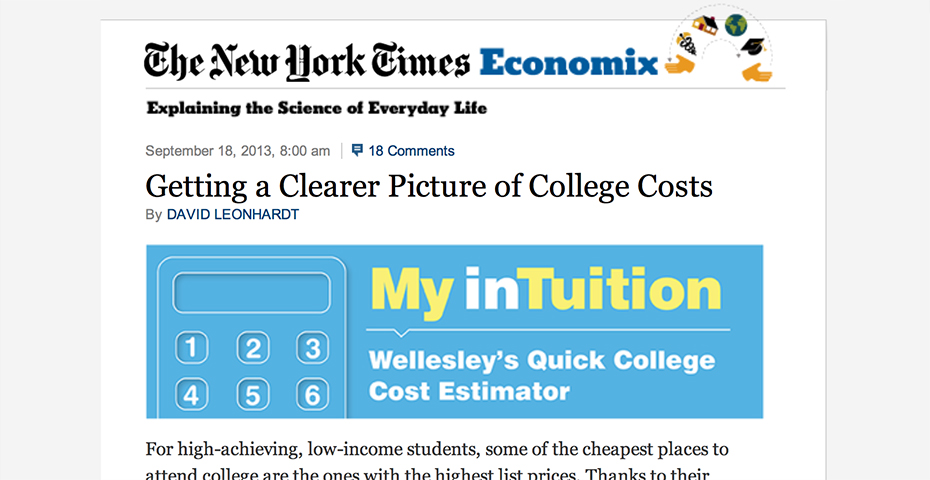New York Times, Associated Press, Chronicle of Higher Education Cover Release of Wellesley's New Online Tool

On September 18, Wellesley released a new college cost estimation tool that promises to revolutionize the college-shopping process for thousands of prospective students.
My inTuition: Wellesley’s Quick College Cost Estimator, invented by Phillip B. Levine, Katharine Coman and A. Barton Hepburn Professor of Economics, was created in response to a growing need for clarity in college affordability. The New York Times’ David Leonhardt (who spoke with Levine about My inTuition on Wednesday) reported on a recent study that found that only 34 percent of the nation’s top-scoring high school students in the lowest income quartile attended any of the 238 most selective colleges. For Wellesley and other schools dedicated to diversity and inclusion, the new cost estimator will be a powerful tool in combatting the unfortunate reality of economic inequality.
“Until now, there hasn’t been a quick or easy way for students and their families to estimate their actual college costs, particularly when you take financial aid into account,” said Jennifer Desjarlais, Dean of Admission and Financial Aid at Wellesley. “This has posed a problem because we know that so many qualified students rule out schools based on their sticker price. We developed the cost estimator for the beginning of the college search process, when students are first exploring their options.”
Since 2011, the federal government has mandated that colleges and universities offer a net price calculator to provide prospective students with an estimate of the cost of attending the institution. These calculators, like the Net Price Calculator from The College Board, are often challenging to use, requiring answers to 40 or more questions and access to detailed financial records. My inTuition: Wellesley’s Quick College Cost Estimator asks only six financial questions. It also asks whether students are U.S. citizens and how many siblings would be attending college simultaneously.
“The biggest strength of the calculator is its simplicity. For a family that knows its financial information, receiving an estimate can take as little as one minute,” wrote Leonhardt. There is no registration or use of your name. “Wellesley already enrolls a larger percentage of low-income students than many other top colleges, and it’s possible that the calculator may help it enroll more.”
The tool demonstrates that private colleges can be an affordable option. Thanks to Wellesley’s generous financial aid, most individuals can expect to pay far less than the College’s annual comprehensive fee. For many students, that can make Wellesley their most affordable option.
“With almost every major purchase, like a house or a car, you can get a general sense of the kind of product you can afford, even when you’re just shopping around—not so with college. Most individuals don’t learn about the kind of financial aid package they would be qualified to receive until the very end of the process,” Levine said. “We lose good students who never even bother to apply because of this, and we think this is a lost opportunity for us and for those students. Past research shows that providing students early information about college costs makes them more likely to attend college, which increases lifetime earnings substantially.”
Simple tools like My inTuition pave the way for providing accurate information to prospective students across the country. Levine said, “Our new tool is a big step forward in being more clear about our commitment to access, and we hope that other colleges will seriously consider adopting this approach.”
On Wednesday, Levine and Desjarlais also spoke with the Chronicle of Higher Education and Levine spoke with the Associated Press.
